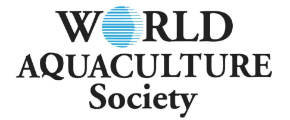THE STATUS OF BLACK SEA BASS Centropristis striata AS A COMMERCIALLY READY SPECIES FOR U.S. MARINE AQUACULTURE
Black sea bass (BSB) Centropristis striata inhabit continental shelf waters of the eastern US and is a member of the family Serranidae comprising true sea basses and groupers. Highly sought by commercial and recreational fishermen, BSB are sustainably managed with 2018 commercial and recreational catch quotas of 1,600 and 1664 mt (3.52 and 3.66 million lbs), respectively.
Wild broodstock are easily caught and adapted to RAS. The initiation and duration of the spawning period are controlled by photothermal conditioning, and eggs and larvae have been produced from Dec through Aug. Pelleted GnRHa (5-10 µg/g bw) implants are effective at inducing ovulation in post-vitellogenic females (> 500 μm MOD). Fertilized eggs (0.94 mm dia.) are obtained by strip-spawning, but induced volitional spawning of multiple females ("group spawning") may yield higher egg quality. As protogynous hermaphrodites, most BSB develop as females and then reverse to male after several years, but methods for control of sex for aquaculture have not been developed.
Yolksac larvae (YSL, d0 post-hatching = d0ph, 3.0 mm TL) are reared to the post-metamorphic (p-m) stage in RAS using standard protocols for marine finfish, including greenwater Nannochloropsis oculata and enriched rotifers (d2 to d22ph), Artemia nauplii (d16ph-d22ph) and enriched metanauplii (d23 to d36ph), co-feeding microparticulate diets (55.5-59% CP, 10-15% CL) from d17ph, with complete weaning from live feeds by d36ph. Environmental optima for larvae are temperature (19-22oC), salinity (28-36 g/L), light intensity (1,500 lx), and photoperiod (16 L: 8 D). A 2,000-L LRT stocked at 25-30 YSL/L yields ~ 7,500 p-m stage (0.5 g) on d47ph (S = 12-15%). Early p-m juveniles are raised in NTs to a transport-ready stage (1.5 g, d58ph) at densities of up to 6.5 fish/L, with excellent resistance to crowding. Juveniles efficiently utilize diets with high proportions of non-fish meal proteins.
Advanced fingerlings stocked in 16-m3 RAS tanks (103 fish/m3) at 33 g/L and 21oC and fed a commercial pelleted diet (55% CP, 15% CL) reached average marketable sizes of 1 lb (454 g), 1.25 lb (568 g), and 1.5 lb (682 g, range = 328-1,350 g) in 17, 20.2, and 22.9 mos. post-hatching, respectively, with high growth variation. FCR was 1.1-1.2, and biomass density at harvest was 55 kg/m3. BSB are tolerant of high-density RAS culture. Cataracts and Pasteurella piscicida infections are controlled by degassing and immersion vaccination, respectively.
Traditional wholesale pricing for ocean-caught whole BSB (0.75 lb - > 2.0 lb) is size-tiered, with higher per prices per lb for larger fish. BSB growers target alternative niche markets for ultra-fresh (live or whole) product, which garner premium prices per lb for fish of assorted sizes. Availability of BSB fingerlings from UNCW's hatchery has enabled startup RAS farmers on the eastern seaboard to grow and to market BSB, but full commercial development will require investment in research to lower production costs. Priorities include increasing growth and minimizing size variation through selective breeding and sequential grading, maximizing biomass densities in RAS, and lowering feed and fingerling costs.













